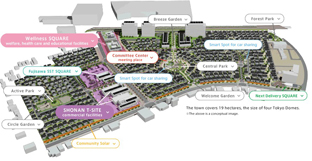Sustainable Smart Town Provides Better Lifestyles as the Entire Town
Sustainable Smart Town Provides Better Lifestyles as the Entire Town
(This article is as of September 2021)
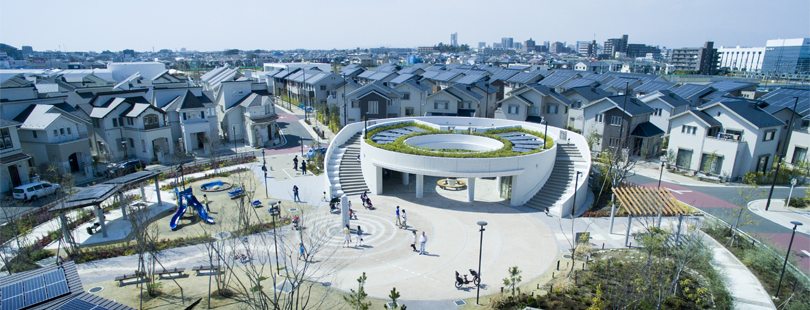
In Fujisawa City, Kanagawa Prefecture, the Fujisawa Sustainable Smart Town (Fujisawa SST) is designed for sustainability with an eye to what the world will look like 100 years from now. Situated on an expansive 19-hectare plot of land, the town, when completed, will comprise more than 1,000 houses, together with wellness, welfare, and educational facilities, as well as commercial facilities and meeting places. These are all supported by five smart services created on the basis of actual lifestyles of the town's residents: energy, security, mobility, wellness, and community. Panasonic’s solutions, which leverage our technologies and overall capabilities in cooperation with our partner companies, local governments, and other organizations, are bringing to better lifestyles that are eco-friendly and smart.
In Fujisawa City, Kanagawa Prefecture, the Fujisawa Sustainable Smart Town (Fujisawa SST) is designed for sustainability with an eye to what the world will look like 100 years from now. Situated on an expansive 19-hectare plot of land, the town, when completed, will comprise more than 1,000 houses, together with wellness, welfare, and educational facilities, as well as commercial facilities and meeting places. These are all supported by five smart services created on the basis of actual lifestyles of the town's residents: energy, security, mobility, wellness, and community. Panasonic’s solutions, which leverage our technologies and overall capabilities in cooperation with our partner companies, local governments, and other organizations, are bringing to better lifestyles that are eco-friendly and smart.
Contributions to Sustainable Development Goals (SDGs)
Contributions to Sustainable Development Goals (SDGs)

Goal 11: Sustainable cities and communities
We carry forward the sustainably evolving urban development through the concept and process based on actual lifestyles, with the goal of bringing energy to life over the next 100 years onward.
Goal 11: Sustainable cities and communities
We carry forward the sustainably evolving urban development through the concept and process based on actual lifestyles, with the goal of bringing energy to life over the next 100 years onward.

Goal 17: Partnerships for the goals
The project will continue to generate new initiatives that will lead to solutions for issues of the community through cooperation among partner companies, Fujisawa City, universities, and residents of the community.
Goal 17: Partnerships for the goals
The project will continue to generate new initiatives that will lead to solutions for issues of the community through cooperation among partner companies, Fujisawa City, universities, and residents of the community.






Beginning with Utilization of a Former Plant Site, Contributing to the Community and Expanding Business through Sustainable Urban Development
Beginning with Utilization of a Former Plant Site, Contributing to the Community and Expanding Business through Sustainable Urban Development
The initial concept for a Sustainable Smart Town (SST) goes back more than ten years. As business currents continued to take production to many sites outside of Japan, the use of former plant sites throughout the country was beginning to become an issue. Some of Panasonic's younger employees wondered if there wasn’t a better way to leverage the sites to lead to development for the community and business, instead of simply selling them. This idea prompted further discussion during their study sessions that led to an urban development proposal to Fujisawa City.
Behind this idea was our founder’s philosophy that we should contribute to the development of society and invigorate local communities through our business activities, and based on his philosophy, we wanted to continue to give back to the community that had given us a home for so long, even if we were no longer able to maintain a plant there. Urban development is one field in which Panasonic can take on new challenges by creating solutions that leverage our technologies and overall capabilities, leading to experience and knowledge that can be shared with society at large. These efforts also provide an arena for co-creation with all kinds of different partners.
To achieve urban development that extended beyond the experimentation and testing phases, Panasonic decided to aim for a sustainable smart town, placing an emphasis on sustainability and letting the implementation of smart technologies and systems follow that goal.
The initial concept for a Sustainable Smart Town (SST) goes back more than ten years. As business currents continued to take production to many sites outside of Japan, the use of former plant sites throughout the country was beginning to become an issue. Some of Panasonic's younger employees wondered if there wasn’t a better way to leverage the sites to lead to development for the community and business, instead of simply selling them. This idea prompted further discussion during their study sessions that led to an urban development proposal to Fujisawa City.
Behind this idea was our founder’s philosophy that we should contribute to the development of society and invigorate local communities through our business activities, and based on his philosophy, we wanted to continue to give back to the community that had given us a home for so long, even if we were no longer able to maintain a plant there. Urban development is one field in which Panasonic can take on new challenges by creating solutions that leverage our technologies and overall capabilities, leading to experience and knowledge that can be shared with society at large. These efforts also provide an arena for co-creation with all kinds of different partners.
To achieve urban development that extended beyond the experimentation and testing phases, Panasonic decided to aim for a sustainable smart town, placing an emphasis on sustainability and letting the implementation of smart technologies and systems follow that goal.
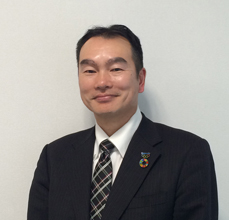
Tomohiko Miyahara, General Manager, CRE Business Development Group
※as of September 2021
(Current title is director, Business Solution Division)
Tomohiko Miyahara, General Manager, CRE Business Development Group
※as of September 2021
(Current title is director, Business Solution Division)
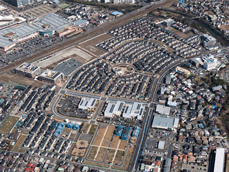
Urban Development Based on Actual Lifestyle as Only Panasonic Can Provide: A Participatory Model for Sustainable Towns
Urban Development Based on Actual Lifestyle as Only Panasonic Can Provide: A Participatory Model for Sustainable Towns
Conventional smart city designs start with smart infrastructure from which the town designs and spaces are based. This way of doing things has often proven unsustainable. As a manufacturer of home electronics, Panasonic has a history of creating electronics and appliances based on their value in the context of a customer's lifestyle. This approach based on actual lifestyles begins with asking what smart life will look like 10, 20, and even 100 years from now. From there, we start thinking about how to build the spaces, infrastructure, and services that will help make that vision a reality. Panasonic is unique in our ability to offer this type of urban development based on actual lifestyles that focuses on sustainability.
To make a town truly sustainable, we need to involve its residents in building a community. With the participation of partner companies that implement advanced initiatives, innovation through co-creation among industry, government and education along with residents will be generated. One example of such an initiative is the Fujisawa SST Town Parent Project, which involves cooperation between 18 different businesses, universities, local government agencies, and local resident organizations. The town's development is moving forward with cooperation from a variety of different partners, and, when validating new services and technologies, residents will be able to participate in monitoring and will have opportunities for exchanging opinions during town meetings.
Conventional smart city designs start with smart infrastructure from which the town designs and spaces are based. This way of doing things has often proven unsustainable. As a manufacturer of home electronics, Panasonic has a history of creating electronics and appliances based on their value in the context of a customer's lifestyle. This approach based on actual lifestyles begins with asking what smart life will look like 10, 20, and even 100 years from now. From there, we start thinking about how to build the spaces, infrastructure, and services that will help make that vision a reality. Panasonic is unique in our ability to offer this type of urban development based on actual lifestyles that focuses on sustainability.
To make a town truly sustainable, we need to involve its residents in building a community. With the participation of partner companies that implement advanced initiatives, innovation through co-creation among industry, government and education along with residents will be generated. One example of such an initiative is the Fujisawa SST Town Parent Project, which involves cooperation between 18 different businesses, universities, local government agencies, and local resident organizations. The town's development is moving forward with cooperation from a variety of different partners, and, when validating new services and technologies, residents will be able to participate in monitoring and will have opportunities for exchanging opinions during town meetings.
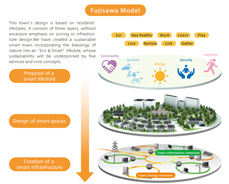
Eco-friendly and Smart Lifestyles Supported by Five Smart Services
Eco-friendly and Smart Lifestyles Supported by Five Smart Services

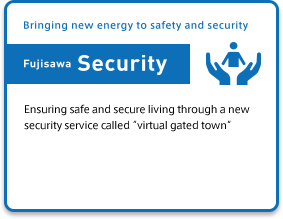
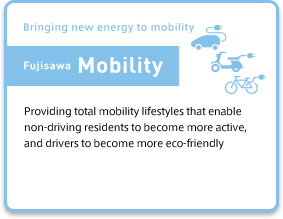
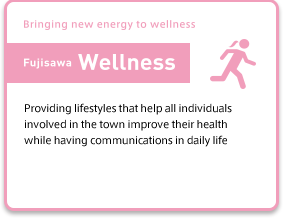






Launched in 2011, the project began with setting a series of numerical targets and guidelines for the entire town. We started out with environmental and energy-related targets, deciding to reduce CO2 emissions by 70%, reduce water consumption by 30%, and have renewable energy usage account for at least 30% of total energy as some of our key targets. We also set a safety and security target of establishing lifelines that would last for three days in the face of disasters.
This approach to urban development is made possible by five smart services provided by Panasonic: energy, security, mobility, wellness, and community. Fujisawa SST has generated a wide variety of initiatives that are leading to solutions to challenges of the community through these services.
Energy:
All detached homes are equipped with solar power generation systems and storage batteries to manage energy use for efficiency. Self-creation and self-consumption of energy make it possible to ensure that lifelines will last for at least three days during disasters.
Security:
We have created safety and security objectives and guidelines, with the goal of building a self-sufficient and cooperative town, to be used for disaster response during emergencies and crime prevention in non-emergencies. We have also implemented a system for push notifications to smart TVs to deliver disaster- or emergency-related information to residents.
Mobility:
In light of the shift from ownership to use in society and the growth of the sharing economy, we have also implemented shared services, including electric vehicles and electric bicycles. Panasonic is a home appliance manufacturer, but housing and automotive fields are also strategic business areas for us, meaning we can really show off our strengths in mobility-focused urban development.
We have also deployed the first secondary town-wide delivery service in Japan. All packages from all carriers are handled by Yamato Transport once they reach the town. Through Panasonic’s Information technologies, residents can specify delivery times and locations using smartphones and smart TVs, as well as receive notifications. Through initiatives like this, we are working on solving issues for transport companies, and society at large, by reducing re-deliveries, reducing costs, and reducing CO2 emissions, while also addressing labor shortages.
Wellness:
We are developing a comprehensive wellness center that combines elderly care facilities, assisted residences for the elderly, nursery centers, after-school day-care centers and cram schools all in one facility. This will create more opportunities for intergenerational interactions, leading to better emotional development for children.
Care facilities feature smart air conditioning services that use Panasonic technologies. Using sensors that detect movement makes it possible to not only manage factors like temperature and humidity, but also provide for safe and secure nursing services by tracking life rhythms, including, for example, patients’ sleep habits.
We are also working on building a system that will match healthy seniors that lack opportunities to make a contribution with others who need assistance in senior care facilities, which often face shortages of workers.
Community:
We maintain a portal site that connects residents with Fujisawa SST. Residents can use smart devices like their smartphones and smart TVs to get information on local events, information on disaster prevention, energy usage for each household, mobility sharing service reservations, and more. This system also allows residents to broadcast their own opinions and participate in the urban development.
Launched in 2011, the project began with setting a series of numerical targets and guidelines for the entire town. We started out with environmental and energy-related targets, deciding to reduce CO2 emissions by 70%, reduce water consumption by 30%, and have renewable energy usage account for at least 30% of total energy as some of our key targets. We also set a safety and security target of establishing lifelines that would last for three days in the face of disasters.
This approach to urban development is made possible by five smart services provided by Panasonic: energy, security, mobility, wellness, and community. Fujisawa SST has generated a wide variety of initiatives that are leading to solutions to challenges of the community through these services.
Energy:
All detached homes are equipped with solar power generation systems and storage batteries to manage energy use for efficiency. Self-creation and self-consumption of energy make it possible to ensure that lifelines will last for at least three days during disasters.
Security:
We have created safety and security objectives and guidelines, with the goal of building a self-sufficient and cooperative town, to be used for disaster response during emergencies and crime prevention in non-emergencies. We have also implemented a system for push notifications to smart TVs to deliver disaster- or emergency-related information to residents.
Mobility:
In light of the shift from ownership to use in society and the growth of the sharing economy, we have also implemented shared services, including electric vehicles and electric bicycles. Panasonic is a home appliance manufacturer, but housing and automotive fields are also strategic business areas for us, meaning we can really show off our strengths in mobility-focused urban development.
We have also deployed the first secondary town-wide delivery service in Japan. All packages from all carriers are handled by Yamato Transport once they reach the town. Through Panasonic’s Information technologies, residents can specify delivery times and locations using smartphones and smart TVs, as well as receive notifications. Through initiatives like this, we are working on solving issues for transport companies, and society at large, by reducing re-deliveries, reducing costs, and reducing CO2 emissions, while also addressing labor shortages.
Wellness:
We are developing a comprehensive wellness center that combines elderly care facilities, assisted residences for the elderly, nursery centers, after-school day-care centers and cram schools all in one facility. This will create more opportunities for intergenerational interactions, leading to better emotional development for children.
Care facilities feature smart air conditioning services that use Panasonic technologies. Using sensors that detect movement makes it possible to not only manage factors like temperature and humidity, but also provide for safe and secure nursing services by tracking life rhythms, including, for example, patients’ sleep habits.
We are also working on building a system that will match healthy seniors that lack opportunities to make a contribution with others who need assistance in senior care facilities, which often face shortages of workers.
Community:
We maintain a portal site that connects residents with Fujisawa SST. Residents can use smart devices like their smartphones and smart TVs to get information on local events, information on disaster prevention, energy usage for each household, mobility sharing service reservations, and more. This system also allows residents to broadcast their own opinions and participate in the urban development.
Sustainable Smart Towns Are Attracting Attention, But What Do They Really Do for the Community and Business?
Sustainable Smart Towns Are Attracting Attention, But What Do They Really Do for the Community and Business?
Fujisawa SST has been the subject of much attention, both from within Japan and around the world since it first opened in 2014. More than 25,000 people have already taken the tours for business stakeholders, and recently, one in four visitors has been from outside Japan. The reason for this turnout is a general growing interest in sustainable urban development and the Sustainable Development Goals (SDGs). Panasonic's work in this area predates the SDGs, and this project alone contributes to the achievement of eight of the 17 goals included in the SDGs. Goals 11 (Sustainable cities and communities) and 17 (Partnerships for the goals) are the two that are most especially relevant to our work on this project. Our efforts with Fujisawa SST have been met with high praise, including the selection of Kanagawa Prefecture as both SDGs Future Cities (one of 29) by the Cabinet Office and as a Local Government SDGs Model Project (one of 10) which is in particular a pioneering case, in 2018.
Fujisawa SST has been the subject of much attention, both from within Japan and around the world since it first opened in 2014. More than 25,000 people have already taken the tours for business stakeholders, and recently, one in four visitors has been from outside Japan. The reason for this turnout is a general growing interest in sustainable urban development and the Sustainable Development Goals (SDGs). Panasonic's work in this area predates the SDGs, and this project alone contributes to the achievement of eight of the 17 goals included in the SDGs. Goals 11 (Sustainable cities and communities) and 17 (Partnerships for the goals) are the two that are most especially relevant to our work on this project. Our efforts with Fujisawa SST have been met with high praise, including the selection of Kanagawa Prefecture as both SDGs Future Cities (one of 29) by the Cabinet Office and as a Local Government SDGs Model Project (one of 10) which is in particular a pioneering case, in 2018.
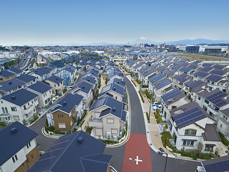
Fujisawa SST has also served as a test case for a broad range of technologies and initiatives, including housing, facility, and B2B solutions. Three key factors enable us to work cooperatively and consult with many different businesses and local government organizations: 1.) living spaces and mobility, essential elements for towns, are one of our strategic areas of business; 2.) we have the technology and ingenuity, beyond lifestyle needs, by developing B2B co-creation in a broad range of business fields; and 3.) the strong philosophy of our founder form the backbone of this project.
Fujisawa SST has also served as a test case for a broad range of technologies and initiatives, including housing, facility, and B2B solutions. Three key factors enable us to work cooperatively and consult with many different businesses and local government organizations: 1.) living spaces and mobility, essential elements for towns, are one of our strategic areas of business; 2.) we have the technology and ingenuity, beyond lifestyle needs, by developing B2B co-creation in a broad range of business fields; and 3.) the strong philosophy of our founder form the backbone of this project.
Toward a New Future: Sustainable Smart Towns Across the Country and the World
Toward a New Future: Sustainable Smart Towns Across the Country and the World
Fujisawa SST is currently 70% operational and is planned for completion in 2022. One critical element in thinking about the future in urban development planning is to backcast from 2030. To do so, predicting changes in the town’s population and striking a balance are key concepts. The ideal is to have a community with multiple generations living together, as well as movement throughout the city. If there are only long-term residents in the community, population dynamics will stagnate. We are also considering creating a variety of spaces in different styles that include shared housing and social spaces where younger people can live, work, and visit. We use town data to create demographic maps that predict future population distributions in the town to create services. We hope that our efforts to use data and our technological experience for urban development will lead to expansion in this exciting business field.
Fujisawa SST is currently 70% operational and is planned for completion in 2022. One critical element in thinking about the future in urban development planning is to backcast from 2030. To do so, predicting changes in the town’s population and striking a balance are key concepts. The ideal is to have a community with multiple generations living together, as well as movement throughout the city. If there are only long-term residents in the community, population dynamics will stagnate. We are also considering creating a variety of spaces in different styles that include shared housing and social spaces where younger people can live, work, and visit. We use town data to create demographic maps that predict future population distributions in the town to create services. We hope that our efforts to use data and our technological experience for urban development will lead to expansion in this exciting business field.
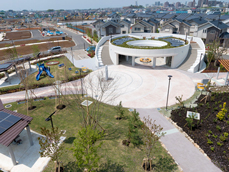
We believe that SDGs need to be achieved so that no one may be left behind, through the full participation of everyone. We want each and everyone to understand that the SDGs are not mere goals, are not something of the far-off future, and are not solely the problems of some far-off place. Instead, we want all people to ask themselves what they can and should do now for the future, and then to go do it. This project has helped us to understand first-hand just how crucial this is.
Tsunashima in Yokohama City is now running as the second SST project, and a third urban development is planned for Osaka. Panasonic is not the only company that is faced with dealing with former plant sites and idle lands. We have had a growing number of inquiries from many other companies and local government organizations, and we are beginning to start to provide them with proposals based on our experience and know-how. I hope to continue to work on urban development projects that are based, first and foremost, on actual lifestyles in the future, all the while remaining aware of sustainability and SDGs, and working together with various kinds of partners, both in Japan and around the world.
The SST project started with a small study group more than ten years ago, but the initial motivation behind it remains unchanged and has shaped the project as it is today. I hope that those who work on this project after me will continue to make ongoing contributions toward the achievement of the SDGs through SST.
We believe that SDGs need to be achieved so that no one may be left behind, through the full participation of everyone. We want each and everyone to understand that the SDGs are not mere goals, are not something of the far-off future, and are not solely the problems of some far-off place. Instead, we want all people to ask themselves what they can and should do now for the future, and then to go do it. This project has helped us to understand first-hand just how crucial this is.
Tsunashima in Yokohama City is now running as the second SST project, and a third urban development is planned for Osaka. Panasonic is not the only company that is faced with dealing with former plant sites and idle lands. We have had a growing number of inquiries from many other companies and local government organizations, and we are beginning to start to provide them with proposals based on our experience and know-how. I hope to continue to work on urban development projects that are based, first and foremost, on actual lifestyles in the future, all the while remaining aware of sustainability and SDGs, and working together with various kinds of partners, both in Japan and around the world.
The SST project started with a small study group more than ten years ago, but the initial motivation behind it remains unchanged and has shaped the project as it is today. I hope that those who work on this project after me will continue to make ongoing contributions toward the achievement of the SDGs through SST.

